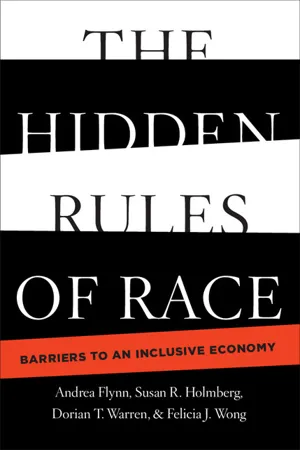
The Hidden Rules of Race
Barriers to an Inclusive Economy
- English
- PDF
- Available on iOS & Android
The Hidden Rules of Race
Barriers to an Inclusive Economy
About this book
Why do black families own less than white families? Why does school segregation persist decades after Brown v. Board of Education? Why is it harder for black adults to vote than for white adults? Will addressing economic inequality solve racial and gender inequality as well? This book answers all of these questions and more by revealing the hidden rules of race that create barriers to inclusion today. While many Americans are familiar with the histories of slavery and Jim Crow, we often don't understand how the rules of those eras undergird today's economy, reproducing the same racial inequities 150 years after the end of slavery and 50 years after the banning of Jim Crow segregation laws. This book shows how the fight for racial equity has been one of progress and retrenchment, a constant push and pull for inclusion over exclusion. By understanding how our economic and racial rules work together, we can write better rules to finally address inequality in America.
Frequently asked questions
- Essential is ideal for learners and professionals who enjoy exploring a wide range of subjects. Access the Essential Library with 800,000+ trusted titles and best-sellers across business, personal growth, and the humanities. Includes unlimited reading time and Standard Read Aloud voice.
- Complete: Perfect for advanced learners and researchers needing full, unrestricted access. Unlock 1.4M+ books across hundreds of subjects, including academic and specialized titles. The Complete Plan also includes advanced features like Premium Read Aloud and Research Assistant.
Please note we cannot support devices running on iOS 13 and Android 7 or earlier. Learn more about using the app.
Information
Table of contents
- Cover
- Half-title
- Series information
- Title page
- Copyright information
- Table of contents
- Notes on contributors
- Acknowledgments
- Introduction
- 1 American Politics and Economic Outcomes for African Americans
- 2 Stratification Economics
- 3 Creating Structural Changes
- 4 The Racial Rules of Wealth
- 5 The Racial Rules of Income
- 6 The Racial Rules of Education
- 7 The Racial Rules of Criminal Justice
- 8 The Racial Rules of Health
- 9 The Racial Rules of Democratic Participation
- 10 What Will It Take to Rewrite the Hidden Rules of Race?
- Conclusion
- Notes
- Index